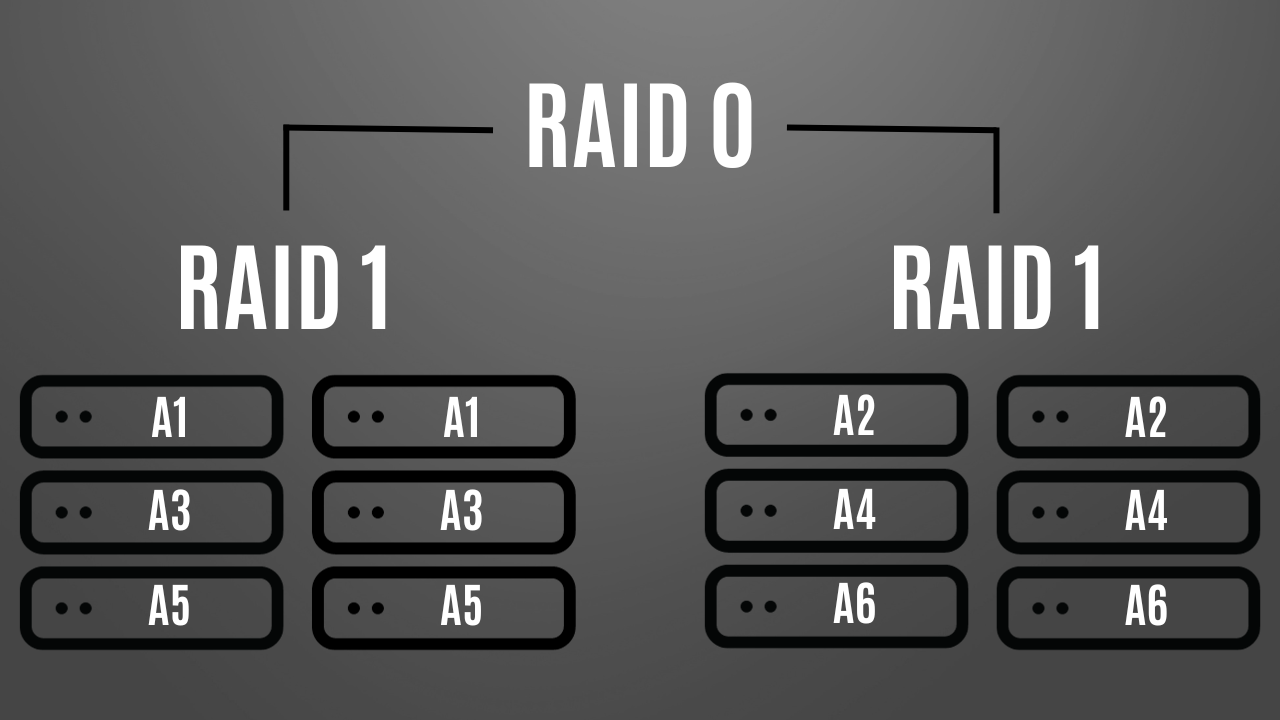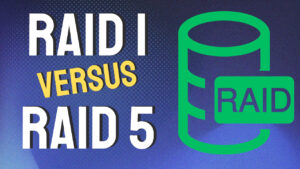In this article, we’re going to look at RAID 6 vs RAID 10 to determine the best RAID type that you can use. RAID (Redundant Array of Independent Disks) combines multiple hard disks into one logical unit.
This increases performance and reliability, as individual hard drives can fail without losing data. Performance is also increased because multiple hard drives are working together at the same time. There are other key differences between RAID 6 vs RAID 10 which will ultimately determine which option to use.
RAID 6 vs RAID 10: Which RAID Option is Best?
The main difference between RAID 6 and RAID 10 is that RAID 6 can withstand two concurrent drive failures without data loss, but data loss may occur with RAID 10 depending on the mirrored pair the hard disks are part of. RAID 10 (RAID 1+0) offers better overall performance than RAID 6 for read, write, and RAID rebuild processing. We will dive into some other key differences below.
What is RAID 6?
RAID 6 uses double parity which means that you need to have at least four total drives for a RAID 6 array. The drives in a RAID 6 array will work together to allow for any two hard drives to fail without losing any data.
RAID 6 is generally a great option for certain RAID arrays where you want more protection than RAID 5 produces, but don’t want to utilize the total hard drives that RAID 10 requires.
What is RAID 10?
RAID 10 is also written as RAID 1+0 because it’s a hybrid of RAID 1 and RAID 0. RAID 10 requires four minimum hard drives, but the data is mirrored across the drives the same way it is with RAID 1.
The benefit that RAID 10 provides is the data is striped, which increases the performance by functioning similarly to RAID 0 but has good overall data protection by mirroring the data like RAID 1.
RAID 10

So in summary, you’re basically using RAID 1 and RAID 0 at the same time, which can be helpful if redundancy and performance are important to you. However, since RAID 10 requires mirrored drives, its total usable capacity is lower than RAID 6.
Data Protection
From a pure data protection standpoint, comparing RAID 6 vs RAID 10 is actually more complicated than it might seem due to how the data is written with RAID 10.
When using RAID 6, you are limited to two concurrent drive failures before losing data. Therefore, three total disks have to fail at the same time in order for data loss to occur. Overall, this is strong protection and RAID 6 is viewed as a great option for data protection.
With RAID 10, it’s a lot more complicated. In the simplest RAID 10 configuration (4 total drives, which is 2 mirrored pairs), you can theoretically lose up to 2 drives without losing data, but they must be one drive from each of the mirrored pairs. If both drives from the same mirrored pair fail, then you will lose data.
Here are some examples with larger RAID 10 arrays:
- If you have 6 drives (3 mirrored pairs), you can lose up to 3 drives without losing data, but again, they must be one drive from each of the mirrored pairs.
- If you have 8 drives (4 mirrored pairs), you can lose up to 4 drives, but they must be one drive from each of the mirrored pairs.
- This will continue to go on no matter how large the pool is. You cannot lose two drives in the same mirrored pair if you don’t want to lose data. As long as they’re not in the same mirrored pair, you will not lose data.
For this reason, RAID 10 will always have a minimum of two drives it can lose, but the maximum is higher. The downside is that you can’t actually utilize any of the storage space of the other drives since they’re mirrored.
It’s also important to note that the more drives you lose (whether you’re using RAID 6 or RAID 10), the higher the risk of another drive failing before you can replace and rebuild the failed one.
For these reasons, RAID 6 is viewed as providing better protection from drive failures due to the fact that any two drives can fail, and three total drives must fail to lose data. With RAID 10, two drive failures in the same mirror will cause data loss.
Disk Utilization
Simply put, RAID 6 provides a higher usable capacity due to the fact that it uses double parity. Therefore, if you have a storage pool with eight total 10TB drives, RAID 6 will provide you with six total drives of usable storage (60TB). RAID 10 will produce a striped mirror, which will produce a total of four mirrored pairs, or 40TB of usable space.
Here’s an example using Synology’s RAID Calculator.

If your pure goal is to maximize storage, RAID 6 will always provide more total storage space for RAID arrays larger than four total drives.
Performance
Overall, RAID 10 offers better performance than RAID 6 but we’ll look a little deeper into why by comparing read and write performance differences.
RAID 10 Read Performance
RAID 10 offers great read performance since data is striped across multiple drives. This also allows for multiple copies of the data due to the way it’s mirrored, allowing for multiple read operations to be serviced by multiple drives simultaneously.
RAID 6 read performance is generally good, but it’s not as fast as RAID 10 due to the parity calculations that RAID 6 utilizes.
RAID 10 Write Performance
Write operations are faster with RAID 10 than with RAID 6 since the data is written directly to the disks (due to mirroring). This allows the data to be written without requiring the parity calculations that RAID 6 utilizes (which is used for fault tolerance).
This all leads to better overall performance for RAID 10, but as mentioned above, potentially lower data protection. Overall, if you care about performance and need the most performant RAID array from a read/write perspective, go with RAID 10.
RAID Rebuild Performance: RAID 6 vs. RAID 10
The final performance metric is in terms of the actual rebuild process, assuming it’s required. Once again, RAID 10 is faster from a rebuild perspective since the data is mirrored and can be directly copied to the new hard drive without requiring parity calculations.
RAID 6 is more time-consuming (and resource-intensive) since the missing data has to be recalculated from the existing data and parity information. This process can also be more taxing on the existing hard disks.
Should You Use RAID 6 or RAID 10?
When picking between RAID 6 or RAID 10, the decision comes down to a few key requirements:
- If your goal is data protection, RAID 6 is a better overall option since it can withstand the loss of any two hard disks. RAID 10 is vulnerable from that perspective to two drive failures in the same mirrored pair.
- If you want to maximize the storage capacity, RAID 6 will provide higher a overall capacity due to the data being written across multiple drives (and only losing the storage space of two total disks for parity).
- Since RAID 10 is a mirror, you’ll only have half the total disks as usable storage.
- If performance is the most important goal, or you simply want the best overall performance and protection, RAID 10 is a better choice.
Conclusion & Final Thoughts
RAID 6 vs RAID 10 really comes down to the data protection and performance requirements. If data protection is incredibly important, you should go with RAID 6. If performance is important, you should go with RAID 10. In situations where you need a mix between data protection and performance, you need to determine the best option based on the other requirements that exist and determine if data protection or performance is more important.
Thanks for checking out the article on RAID 6 vs RAID 10. If you have any questions, please leave them in the comments!




